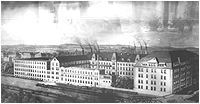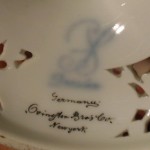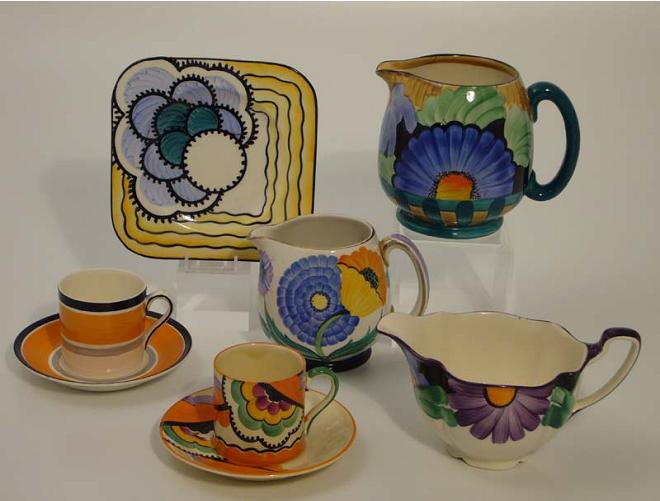The term “Dresden porcelain” refers more to an artistic movement than a particular line of figurines or dinnerware. Several decorating studios emerged in this Saxony capital in response to the rise of “Romanticism” during the 19th century. Dresden was an important centre of this artistic, cultural and intellectual movement, which attracted painters, sculptors, poets, philosophers and porcelain decorators alike. In 1883, in response to the exciting developments happening all around them, four prominent ceramic decorators registered the famous blue crown Dresden mark, and the widely popular “Dresden style” was born.
Much confusion exists concerning the relationship between the names “Dresden” and “Meissen,” which are often used interchangeably. This misunderstanding dates to the earliest years of porcelain production in Europe. The secret of hard paste porcelain, previously the exclusive knowledge of the Chinese and Japanese exporters, was actually discovered under the commission of Augustus the Strong in the city of Dresden
The first porcelain-producing factory, however, was begun fifteen miles away in the city of Meissen, in 1710. However, as Dresden was a vital cultural and economic centre of Saxony, most Meissen china was sold there. As a result, much Meissen china and figurines, characterized by the blue cross-swords stamp, were mistakenly referred to as “Dresden.” Modern day collectors, however, distinguish Meissen from the china produced by decorators in the city of Dresden beginning in the 19th century, which generally bear a blue crown stamp or other related mark. While the work of Dresden decorators often rivalled that produced in Meissen, no actual porcelain was produced in Dresden. That aspect of the process, at least, remained the exclusive pride of Meissen factories.
Dresden china is often described as “rococo revival” style. Rococo comes from the French word “rocaille” meaning rock work or grotto work, and refers to the artificial grottoes used in French gardens that were decorated with irregularly shaped stones and seashells. Originally popular during the renaissance, rococo experienced a revival during the 19th century, touching virtually all aspects of interior design. Dresden decorators were the first and most successful to employ this style on dinnerware, characterized by elaborate fanciful design and a profusion of foliage, flowers, fruits, shells and scrolls.
Although there were over 200 painting shops in Dresden alone between 1855 and 1944, the Dresden style is typically associated with the blue crown stamp first registered by Richard Klemm, Donath & Co., Oswald Lorenz, and Adolph Hamann in 1883. The style they employed was a mixture of Meissen and Vienna flower and figure painting. Later, other decorators employed the Crown and Dresden mark, and such names as Franziska Hirsch, Ambrosius Lamm, Carl Thieme (vases/urns, decorative) and Helena Wolfsohn have also become synonymous with Dresden china.
Dresden History
1708 When the white gold was born
In 1708, Johann Friedrich Böttger and his team discovered the secret of the porcelain production, arcanum. Since that time Dresden is known as the cradle of the white gold, which brought wealth and glory for Saxony.
1872 The foundation of the „Saxon porcelain manufactory of Carl Thieme zu Potschappel-Dresden“
 In the 19th century, there were many porcelain painters in Saxony who did their job at home and brought many new impulses to the traditional porcelain art. They creatively decorated white porcelain bought somewhere else. One of them, Carl Thieme, decided to manufacture his own white pieces. For this reason, he founded the today’s Saxon Porcelain Manufactory in Potschappel in the year 1872. On September 17th 1872 he began with the production of decorative porcelain and man-made porcelain. A broken wall bracket was registered as very first model.
In the 19th century, there were many porcelain painters in Saxony who did their job at home and brought many new impulses to the traditional porcelain art. They creatively decorated white porcelain bought somewhere else. One of them, Carl Thieme, decided to manufacture his own white pieces. For this reason, he founded the today’s Saxon Porcelain Manufactory in Potschappel in the year 1872. On September 17th 1872 he began with the production of decorative porcelain and man-made porcelain. A broken wall bracket was registered as very first model.
1888 The death of Carl Thieme
 One of Thiemes best employees was Karl August Kuntzsch, a talented flower modeller and later his son-in-law and business partner. He founded the big tradition of opulent flower covering which is still very characteristic for Dresden Porcelain. After the death of Thieme he proved himself as a far-sighted entrepreneur who continued the business successfully and introduced Dresden Porcelain to the international markets.
One of Thiemes best employees was Karl August Kuntzsch, a talented flower modeller and later his son-in-law and business partner. He founded the big tradition of opulent flower covering which is still very characteristic for Dresden Porcelain. After the death of Thieme he proved himself as a far-sighted entrepreneur who continued the business successfully and introduced Dresden Porcelain to the international markets.
Around 1900 the triumphal course around the world
Kuntzsch travelled to the United States, organised the export throughout Europe and won international awards and medals for example at the international industrial exhibition in Brussels 1897, at the World exposition in Paris in 1900, and various art exhibitions. He made the Dresden Porcelain world-famous.
1901/02 Registered Trademark
There were different trademarks for Dresden Porcelain in the past. Since 1901, the blue “SP Dresden” (for Saxonian Porcelain Factory Dresden) is a protected trademark guaranteeing the authenticity of Dresden Porcelain.
Famous Exhibitions
The company often took part in industry, art, and world expositions. Numerous gold medals from Antwerp, Chicago, Paris, or Dresden document not only the high quality of the finished goods but also the significant artistic skills of the modelers, sculptors, and painters. Outlet stores were opened in the European capitals of Berlin, Stockholm, London, and Paris.
1914-1971 Difficult times for the Saxon Porcelain Manufactory
In the first world war, these stores needed to be closed for a time. To replace the missing workers, women were trained and a continuous training program was started. Once Karl August Kuntzsch died in 1920, his two sons took over direction of the company. The industrial town of Potschappel was joined together with other towns in the Plauen area to found the new city of Freital.
Although Kuntzsch’s brothers rebuilt the foreign market, the work force of the factory was reduced to not even one hundred in 1929 due to the impending economic crisis. Reduced working hours became the norm. Enamel plates and key fobs were even produced just to keep the painters employed. When the British court ordered a multi-figured coronation set, crockery, vases, and lamps in 1936, the foreign contacts paid for themselves once again.
Starting in 1936, no gold was allowed to be used on the edges of cups, bowls, boxes, or vases. An inconspicuous gold-brown color was used as a substitute. Luckily, the factory remained untroubled by the Second
World War
After 1945, Emil Alfred Kuntzsch slowly started up production again. Since he didn’t want to hand the family business over the the state, he was charged with criminal economic activities under false pretenses and, in 1950, lost control of the factory. The factory was held in trust but slowly transformed into a public work by 1971.
1972-1990 The lost brand
 In 1972 the manufactory was transformed completly into a public work. The factory was focused exclusively on exporting their goods at low prices to obtain foreign currencies. This brought a number of orders to the factory. In order to double production capacity, three modern kilns were imported between 1978 and 1980, and up to 1990, between 160 to 180 workers were employed. At the same time, however, the building fell into disrepair.
In 1972 the manufactory was transformed completly into a public work. The factory was focused exclusively on exporting their goods at low prices to obtain foreign currencies. This brought a number of orders to the factory. In order to double production capacity, three modern kilns were imported between 1978 and 1980, and up to 1990, between 160 to 180 workers were employed. At the same time, however, the building fell into disrepair.
Reprivatization
After reunification, the factory faced a problem it had never faced before. The company, whose products sold without a problem last year, was now facing foreclosure. As a result, many employees were laid off so that the workforce was reduced by 75%.
For the reprivitization, the factory allowed a French banking consortium to act as a trust. After they went bankrupt, they were bought out by a West German group of companies.
Optimism
After this, two former employees again attempted to protect the company and its 33 employees from closure by putting it back on the market with new concepts.
Since then, the quality of the finished goods in the painting and sculpting workshop has steadily improved. Form, decor, and techniques have been further developed and, in 1998, the training of specialized staff began again.
Since then, the quality of the finished goods in the painting and sculpting workshop has steadily improved. Form, decor, and techniques have been further developed and, in 1998, the training of specialized staff began again.
Misunderstanding between Dresden and Meissen.
 This misunderstanding also dates back to the early years when the secret of European hard paste porcelain, was discovered under the commission of Augustus the Strong in the city of Dresden.
This misunderstanding also dates back to the early years when the secret of European hard paste porcelain, was discovered under the commission of Augustus the Strong in the city of Dresden.
In 1710, however, the first porcelain producing factory was set up fifteen miles away in the city of Meissen. But most Meissen porcelain was sold in Dresden, which was the cultural and economic centre of Saxony.
This resulted in Meissen figurines and porcelain being referred to as Dresden porcelain even though they were marked with the blue crossed swords mark.
Today most ceramics collectors are aware that although the work of Dresden decorators often rivaled Meissen products; no actual porcelain was produced in Dresden.
The original Four Companies Were:
 Karl Richard Klemm, located in Striesen and founded in 1869. The Klemm Dresden crown was registrered in the RWZR under number 24.
Karl Richard Klemm, located in Striesen and founded in 1869. The Klemm Dresden crown was registrered in the RWZR under number 24.
Donath & Co, located in the Wachsbleichstrasse 25 and founded in 1872. The Donath Dresden crown was registered in the RWZR under number 25.
Oswald Lorenz, located in Dresden as a commission agent. The Lorenz Dresden crown was registered in the RWZR under number 26.
Adolf Hamman, located in the Serrestrasse 8 and founded in 1866. The Hamman Dresden crown was registered in the RWZR under number 27
All the above studios were decorating porcelain in the meissen or vienna style; and marking their pieces with the sam dresden crown mark. The dresden collector will find it quite impossible to identify the exact origin of wares produced at this time.
After a few years though, each of these studios did register their own specific marks at the RWZR and it became easier to identify indivual studios.
Dresden Marks
Characterised by ornate designs of fruit, shells, foliage, scrolls, and flowers, Dresden china arose during the Romantic period of the 19th century. A blue crown Dresden mark was registered by four ceramic decorators in 1883. Dresden was chosen because the city was a centre of this artistic movement in Europe. However, other marks are considered to be authentic Dresden as well. There are a few tricks to identifying the blue Dresden crown and other associated marks.
Be aware that there was no single Dresden factory, which means that there is no definitive Dresden mark. With more than 40 shops producing Dresden china, the Dresden name and crown differ slightly from one maker to the next. Look at a wide variety of Dresden china items to become familiar with the different marks.
- Look for a blue crown on an item. Some Dresden crowns have 5 points and 3 stars with an elaborate upper case “D” and the word “Germany” underneath. Others have 3 points on the crown with an upper case cursive “D” attached to the crown.
- Look for a blue crown that is similar to an Irish claddagh crown, with 3 points and a centred cross above the crown.
- Check for other authentic Dresden marks, such as the image of a cow with “Dresden” written in cursive beneath it and the words “Made in Germany” printed underneath.
- Look for what appears to be an upper case “N” with a 5-point star underneath and a cursive “Dresden” beneath the star.
- Other authentic Dresden marks include a Bavarian coat of arms with “Dresden” written above it. Some Dresden items also have a small brown rose either above or below the Dresden mark.
- Wolfsohn originally used the Meissen Royal factory mark on her products, in particular a variation of the Meissen AR (Augustus Rex) mark.





































